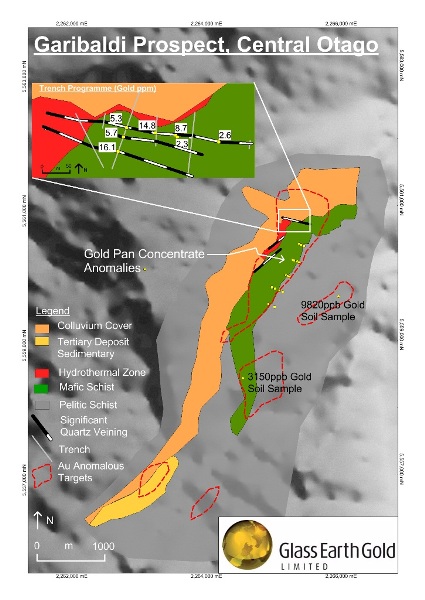Glass Earth Gold (GEL) has announced the discovery of new gold at the Garibaldi project, located in Central Otago. This new gold discovery features a quartz vein network, in which bedrock trench and systematic soil samples have encountered gold grade of up to 16.1 g/t.
 Garibaldi project in Central Otago, New Zealand
Garibaldi project in Central Otago, New Zealand
The strike length of the zone of interest is 900 m. Mineralized arsenic and tungsten is present in the zone of interest.
According to Simon Henderson, Glass Earth Gold’s CEO and President, this gold discovery is a significant growth in previous phase of prospect definition, where the prospective for larger thickness for quartz mineralization and host mafic schist provide potential for the discovery of mesothermal gold. GEL considers this fresh discovery to be a turning point in its exploration of hard rock gold in Central Otago and this discovery demonstrates that the science driven exploration campaign is focused on gold deposit discovery, which is identical to OceanaGold's Macraes gold deposit, he stated.
The company’s exploration program, which follows the main aerial geophysics survey conducted during 2007, showed mafic protoliths to be a significant host to mineralized gold. Regional geochemical surveys identified anomalous gold in soil over 5 x 2 km area and encountered up to 9,750 ppb gold, together with anomalous tungsten and arsenic. Values of anomalous rock chips were found in narrow outcropping quartz veins and supported a trenching campaign in order to outline quartz vein mineralization and host mafic schist over an area of 900 x 300 m. Panel or channel sampling program at anomaly 2 shows consistent east-west orientated quartz vein mineralization and mafic schist.
A large aerial geophysical survey was completed by GEL in New Zealand. The company identified shear zones that are the same as the Hyde-Macraes shear zone, through the electro-magnetic and magnetic information gathered. GEL started on-ground exploration program that directly focuses on these gold-bearing regional structures.